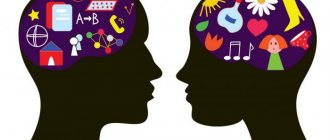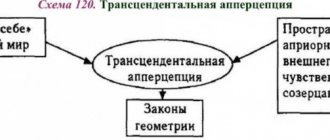INTERACTION OF SENSATIONS
The intensity of sensations depends not only on the strength of the stimuli and the level of adaptation of the receptors, but also on the stimuli currently affecting other sense organs.
A change in the sensitivity of analyzers under the influence of a stimulus from other senses is called interaction of sensations . The interaction of sensations is manifested in an increase and decrease in sensitivity: weak stimuli increase the sensitivity of the analyzers, and strong ones decrease it.
The interaction of sensations is manifested in the phenomena of sensitization , synesthesia and contrast.
Sensitization (from Latin - sensitivity) is an increase in the sensitivity of nerve centers under the influence of an irritant. Sensitization can develop not only through the use of side stimuli, but also through exercise. Thus, musicians develop high auditory sensitivity, tasters develop olfactory and gustatory sensations.
Synesthesia is the occurrence, under the influence of stimulation of a certain analyzer, of a sensation characteristic of another analyzer. For example, during the interaction of sound stimuli, a person may experience visual images. The design of color-musical installations is based on the phenomenon of synesthesia. The phenomenon of synesthesia extends to all modalities. It must be remembered, however, that the manifestations of synesthesia vary from person to person. There are people with a very strong ability for synesthesia and people who have almost no such ability.
This must be taken into account when developing ergonomic measures to reduce fatigue and monotony in the production process (appropriate color scheme for workshop interiors).
Another manifestation of the interaction of sensations is their contrast. The contrast of sensations is a change in the intensity and quality of sensations under the influence of a previous or accompanying stimulus. With the simultaneous action of two stimuli, a simultaneous contrast occurs (examples of this are given when considering visual sensations). The phenomenon of sequential contrast is widely known. The feeling of sour increases sensitivity to sweets. After a cold one, a weak thermal stimulus seems hot.
In conclusion, we note that a person is born with ready-made sense organs and a ready-made ability to sense. However, people differ from each other in their feelings. Individual differences exist in all types of sensations, but are especially noticeable in vision and hearing. They manifest themselves in greater or lesser sensitivity of analyzers, both general and discriminating. Over the course of life, analyzers improve, sensations become more accurate and developed. For example, different people have different degrees of development of musical and phonemic (speech) hearing, which is expressed in the accuracy of distinguishing the pitch of musical sounds and the accuracy of distinguishing phonemes of their native and foreign languages. Persons with well-developed phonemic awareness easily learn foreign languages. At the same time, learning foreign languages contributes to the development of phonemic hearing.
The level of sensitivity depends on the innate characteristics of the analyzers and on the person’s living conditions, his upbringing and the nature of his work. The conditions for the development of a person’s sensations are also his active and varied practical and professional activities. It is known, for example, that experienced steelworkers can determine the temperature with an accuracy of tens of degrees by the subtlest shades of color and brightness of the hot walls and roof of the furnace. Textile workers distinguish several dozen shades of black. Pilots can determine by ear the difference in the number of engine revolutions with an accuracy of 3%.
The development of sensations in professional activity is carried out in relation to the characteristics of this activity. In this case, it is possible, firstly, to increase the sensitivity in the analyzer for which this profession makes demands, and secondly, to increase the sensitivity in those analyzers, thanks to which sensory defects are compensated.
Text of the book “General Psychology: Answers to Examination Papers”
All colors perceived by humans, even those that appear monochromatic, are the result of a complex interaction of light waves of different lengths. Waves of different lengths simultaneously enter the eye, and the waves mix, resulting in a person seeing one specific color. The laws of color mixing were established through the work of Newton and Helmholtz. Of these laws, two are of greatest interest. Firstly, for each chromatic color you can choose another chromatic color, which, when mixed with the first, gives an achromatic color, i.e. white or gray. These two colors are usually called complementary. Secondly, by mixing two non-complementary colors, a third color is obtained - an intermediate color between the first two. One very important point follows from the above laws: all color tones can be obtained by mixing three appropriately selected chromatic colors. This point is extremely important for understanding the nature of color vision.
In order to understand the nature of color vision, let's get acquainted with the theory of three-color vision, the idea of which was put forward by Lomonosov in 1756, expressed 50 years later by T. Jung, and another 50 years later developed in more detail by Helmholtz. According to Helmholtz's theory, the eye is assumed to have the following three physiological apparatuses: red-sensing, green-sensing and violet-sensing. Isolated excitation of the first gives the sensation of red color. The isolated sensation of the second apparatus gives a sensation of green color, and the excitation of the third gives a violet color. However, as a rule, the light simultaneously affects all three devices or at least two of them. In this case, the excitation of these physiological apparatuses with different intensities and in different proportions in relation to each other produces all known chromatic colors. The sensation of white color occurs when all three apparatuses are uniformly excited.
This theory explains well many phenomena, including the disease of partial color blindness, in which a person cannot distinguish individual colors or shades of color. Most often, there is an inability to distinguish shades of red or green. This disease was named after the English chemist Dalton, who suffered from it.
The ability to see is determined by the presence of a retina in the eye, which is a branch of the optic nerve that enters the eyeball from behind. There are two types of apparatus in the retina: cones and rods (so named because of their shape). Rods and cones are the terminal devices of the nerve fibers of the optic nerve. The retina of the human eye has about 130 million rods and 7 million cones, which are unevenly distributed across the retina. Cones fill the central fovea of the retina, that is, the place where the image of the object we are looking at falls. Toward the edges of the retina, the number of cones decreases. There are more rods at the edges of the retina; in the middle they are practically absent.
Cones have low sensitivity. To provoke their reaction, you need a strong enough light. Therefore, with the help of cones, a person sees in bright light. They are also called day vision devices. Rods are more sensitive and can be used to see at night, which is why they are called night vision devices. However, only with the help of cones do people distinguish colors, since they determine the ability to cause chromatic sensations. In addition, cones provide the necessary visual acuity.
There are people whose cone apparatus does not function, and they see everything around them only in gray. This disease is called complete color blindness. Conversely, there are cases when the rod apparatus does not function. Such people cannot see in the dark. Their disease is called hemeralopia
(“night blindness”).
Touch.
It should be noted that the interaction of motor and skin sensations makes it possible to study the subject in more detail.
This process - the process of combining skin and motor sensations - is called touch
. At one time, the interaction of these types of sensations was studied in detail and interesting experimental data were obtained. Thus, various figures were applied to the skin of the forearm of subjects sitting with their eyes closed: circles, triangles, rhombuses, stars, figures of people, animals, etc. However, they were all perceived as circles. The results were only slightly better when these figures were applied to a stationary palm. But as soon as the subjects were allowed to touch the figures, they immediately and accurately determined their shape.
Thanks to the sense of touch, a person can evaluate such properties of objects as hardness, softness, smoothness, roughness.
You should pay attention to the fact that almost all types of sensations are interconnected. Thanks to this interaction, a person can obtain the most complete information about the world around him. However, this information is limited only to information about the properties of objects.
Sensory adaptation and interaction of sensations
Changes in sensitivity depending on environmental conditions are associated with the phenomenon of sensory adaptation. Sensory adaptation
is a change in sensitivity that occurs as a result of the adaptation of a sensory organ to the stimuli acting on it. As a rule, adaptation is expressed in the fact that when the sense organs are exposed to sufficiently strong stimuli, sensitivity decreases, and when exposed to weak stimuli or in the absence of a stimulus, sensitivity increases.
This change in sensitivity does not occur immediately, but requires a certain amount of time. Moreover, the time characteristics of this process are not the same for different sense organs. So, in order for vision in a dark room to acquire the necessary sensitivity, about 30 minutes should pass. Only after this does a person acquire the ability to navigate well in the dark. Adaptation of the auditory organs occurs much faster. Human hearing adapts to the surrounding background within 15 s. The sensitivity of touch also changes quickly (a slight touch to the skin is no longer perceived after just a few seconds).
The phenomena of thermal adaptation (getting used to changes in ambient temperature) are quite well known. However, these phenomena are clearly expressed only in the average range and addiction to extreme cold or extreme heat, as well as to painful stimuli, almost never occurs. The phenomena of adaptation to odors are also known.
Adaptation of sensations mainly depends on the processes occurring in the receptor itself. For example, under the influence of light, visual purple, located in the rods of the retina, decomposes (fades). In the dark, on the contrary, visual purple is restored, which leads to increased sensitivity. However, the phenomenon of adaptation is also associated with processes occurring in the central sections of the analyzers, in particular with changes in the excitability of nerve centers. With prolonged stimulation, the cerebral cortex responds with internal protective inhibition, reducing sensitivity. The development of inhibition causes increased excitation of other foci, contributing to increased sensitivity in new conditions. In general, adaptation is an important process, indicating the greater plasticity of the organism in its adaptation to environmental conditions.
There is one more phenomenon that needs to be considered. All types of sensations are not isolated from each other, therefore the intensity of sensations depends not only on the strength of the stimulus and the level of adaptation of the receptor, but also on the stimuli currently affecting other sense organs. A change in the sensitivity of the analyzer under the influence of irritation of other senses is called the interaction of sensations
.
It is necessary to distinguish two types of interaction of sensations:
1) interaction of sensations of the same type;
2) interaction of sensations of different types.
The interactions of sensations of different types can be illustrated by the research of Academician P. P. Lazarev, who found that illumination of the eyes makes audible sounds louder. Similar results were obtained by Professor S.V. Kravkov. He established that not a single sense organ can work without influencing the functioning of other organs. Thus, it turned out that sound stimulation (for example, a whistle) can sharpen the functioning of the visual sense, increasing its sensitivity to light stimuli. Some odors have a similar effect, increasing or decreasing light and auditory sensitivity. All analyzer systems are capable of influencing each other to a greater or lesser extent. At the same time, the interaction of sensations, like adaptation, manifests itself in two opposite processes - an increase and decrease in sensitivity. The general pattern is that weak stimuli increase, and strong ones decrease, the sensitivity of analyzers during their interaction.
A similar picture can be observed during the interaction of sensations of the same type. For example, a point in the dark is easier to see against a light background. An example of the interaction of visual sensations is the phenomenon of contrast, which is expressed in the fact that a color changes in the opposite direction in relation to the colors surrounding it. For example, gray against a white background will look darker, but when surrounded by black it will look lighter.
As the examples above suggest, there are ways to increase the sensitivity of the senses. Increased sensitivity as a result of the interaction of analyzers or exercise is called sensitization
. A. R. Luria distinguishes two aspects of increased sensitivity according to the type of sensitization. The first is long-term, permanent and depends mainly on lasting changes occurring in the body, so the age of the subject is clearly related to changes in sensitivity. Studies have shown that the sensitivity of the sensory organs increases with age, reaching a maximum by 20–30 years, in order to gradually decrease thereafter. The second side of increased sensitivity according to the type of sensitization is temporary and depends on both physiological and psychological emergency effects on the subject’s condition.
The interaction of sensations is also found in a phenomenon called synesthesia
, – the occurrence, under the influence of irritation of one analyzer, of a sensation characteristic of other analyzers. In psychology, the facts of “colored hearing” are well known, which occurs in many people, and especially in many musicians (for example, Scriabin). Thus, it is widely known that high-pitched sounds are most often regarded by people as “light”, and low-pitched sounds as “dark”.
In some people, synesthesia manifests itself with exceptional clarity. One of the subjects with exceptionally pronounced synesthesia, the famous mnemonist Sh., was studied in detail by A. R. Luria. This person perceived all voices as colored and often said that the voice of the person addressing him, for example, was “yellow and crumbly.” The tones he heard gave him visual sensations of various shades (from bright yellow to purple). The perceived colors were felt by him as “ringing” or “dull”, as “salty” or “crispy”. Similar phenomena in more erased forms occur quite often in the form of an immediate tendency to “color” numbers, days of the week, names of months in different colors. The phenomena of synesthesia are another evidence of the constant interconnection of the analytical systems of the human body, the integrity of the sensory reflection of the objective world.
Patterns of development of sensations in ontogenesis
The sensation begins to develop immediately after the birth of the child. Shortly after birth, the baby begins to respond to stimuli of all kinds. However, there are differences in the degree of maturity of individual feelings and in the stages of their development.
Immediately after birth, the baby's skin sensitivity is more developed. When born, the baby trembles due to the difference in the mother’s body temperature and the air temperature. A newborn baby also reacts to touch, with the lips and the entire mouth area being the most sensitive. It is likely that a newborn can feel not only warmth and touch, but also pain.
Already by the time of birth, the child’s taste sensitivity is quite highly developed. Newborn babies react differently to the introduction of a solution of quinine or sugar into their mouth. A few days after birth, the child distinguishes mother's milk from sweetened water, and the latter from plain water.
From the moment of birth, the child’s olfactory sensitivity is already quite developed. A newborn baby determines by the smell of mother's milk whether the mother is in the room or not. If a child has been fed mother's milk for the first week, he will turn away from cow's milk only when he smells it. However, olfactory sensations not related to nutrition take quite a long time to develop. They are poorly developed in most children, even at four or five years of age.
Vision and hearing go through a more complex path of development, which is explained by the complexity of the structure and organization of the functioning of these sense organs and their lower maturity at the time of birth. In the first days after birth, the baby does not respond to sounds, even very loud ones. This is explained by the fact that the newborn’s ear canal is filled with amniotic fluid, which resolves only after a few days. Usually the child begins to respond to sounds during the first week, sometimes this period lasts up to two to three weeks.
The child's first reactions to sound are of the nature of general motor excitement: the child throws up his arms, moves his legs, and emits a loud cry. Sensitivity to sound is initially low, but increases in the first weeks of life. After two to three months, the child begins to perceive the direction of sound and turns his head towards the sound source. In the third or fourth month, some children begin to respond to singing and music.
As for the development of speech hearing, the child first of all begins to respond to the intonation of speech. This is observed in the second month of life, when a gentle tone has a calming effect on the child. Then the child begins to perceive the rhythmic side of speech and the general sound pattern of words. However, the distinction of speech sounds occurs by the end of the first year of life. From this moment the development of speech hearing itself begins. First, the child develops the ability to distinguish vowels, and at a subsequent stage he begins to distinguish consonants.
A child's vision develops most slowly. Absolute sensitivity to light in newborns is low, but increases markedly in the first days of life. From the moment visual sensations appear, the child reacts to light with various motor reactions. Color discrimination increases slowly. It has been established that a child distinguishes color already in the fifth month, after which he begins to show interest in all kinds of bright objects.
The child, starting to sense light, at first cannot see objects. This is explained by the fact that the child’s eye movements are not coordinated: one eye may look in one direction, the other in the other, or may even be closed. The child begins to control eye movements only at the end of the second month of life. He begins to distinguish objects and faces only in the third month. From this moment, the long-term development of the perception of space, the shape of an object, its size and distance begins.
In relation to all types of sensitivity, it should be noted that absolute sensitivity reaches a high level of development already in the first year of life. The ability to distinguish sensations develops somewhat more slowly. In a preschool child, this ability is developed incomparably less than in an adult. Rapid development of this ability is observed during school years.
It should also be noted that the level of development of sensations varies from person to person. This is largely due to human genetic characteristics.
Perception. Physiological basis of perception
Perception is a holistic reflection of objects, situations, phenomena that arise from the direct impact of physical stimuli on the receptor surfaces of the sense organs.
The concepts of “sensation” and “perception” are interrelated, but there are fundamental differences between them. The essence of sensation processes is to reflect only individual properties of objects and phenomena of the surrounding world. However, a person does not live in a world of isolated spots of light or color, sounds or touches, he lives in a world of things, objects and forms, in a world of complex situations. Whatever a person perceives, everything invariably appears before him in the form of holistic images. Therefore, the main difference between perception and sensation is the objectivity of awareness of everything that affects a person, that is, the display of an object in the real world in the totality of all its properties, or, in other words, a holistic display of the object.
Perception includes sensation and is based on it. Moreover, any perceptual image includes a whole range of sensations, since any object or phenomenon has many and different properties, each of which is capable of causing a sensation, independently of other properties. However, it would be a mistake to believe that such a process (from relatively simple sensations to a complex image of perception) is a simple summation of individual sensations. In fact, the perception (or reflection) of entire objects or situations is much more complex. In addition to sensations, the process of perception involves previous experience, processes of understanding what is perceived, i.e. mental processes of an even higher level, such as memory and thinking, are included in the process of perception. Therefore, perception is often called the human perceptual system.
Currently, there are various theories of the pattern recognition process. These theories focus on the following question: how are external signals affecting the senses transformed into meaningful perceptual images? As a rule, a person recognizes surrounding objects and events easily and quickly; therefore, it may seem that the operations involved in recognition are simple and straightforward. However, this is not at all true. Attempts by engineers to create machines that would be able to recognize symbols and sounds common to the human environment, in most cases end in failure. The perception systems of animals, even the most primitive ones, are far ahead of such machines in their capabilities.
The physiological basis of perception is the processes taking place in the sensory organs, nerve fibers and the central nervous system. Thus, under the influence of stimuli at the endings of the nerves present in the sensory organs, nervous excitation arises, which is transmitted along pathways to the nerve centers and ultimately to the cerebral cortex. Here it enters the projection (sensory) zones of the cortex, which represent, as it were, the central projection of the nerve endings present in the sense organs. Depending on which organ the projection zone is connected to, certain sensory information is generated.
It should be noted that the mechanism described above is the mechanism by which sensations arise. And indeed, at the level of the proposed scheme, sensations are formed. Consequently, sensations can be considered as a structural element of the process of perception. Own physiological mechanisms of perception are included in the process of forming a holistic image at subsequent stages, when excitation from the projection zones is transferred to the integrative zones of the cerebral cortex, where the formation of images of real world phenomena is completed. Therefore, the integrative zones of the cerebral cortex, which complete the process of perception, are often called perceptual zones. Their function differs significantly from the functions of projection zones.
This difference is clearly revealed when the activity of one or another zone is disrupted. For example, when the functioning of the visual projection zone is disrupted, so-called central blindness occurs, i.e., when the periphery - the sensory organs - is completely in working order, the person is completely deprived of visual sensations, he sees nothing. The situation is completely different with lesions or disruption of the integrative zone. A person sees individual spots of light, some contours, but does not understand what he sees. He ceases to comprehend what affects him, and does not even recognize familiar objects. A similar picture is observed when the activity of integrative zones of other modalities is disrupted. Thus, when the auditory integrative zones are disrupted, people cease to understand human speech. Such diseases are called agnostic disorders (disorders leading to the impossibility of cognition), or agnosia.
Since perception is closely related to sensation, it can be assumed that it, like sensation, is a reflexive process. The reflex basis of perception was proved by I. P. Pavlov. He showed that perception is based on conditioned reflexes, i.e. temporary nerve connections formed in the cerebral cortex when receptors are exposed to objects or phenomena in the surrounding world. Moreover, the latter act as complex stimuli, since when processing the excitation caused by them, complex processes of analysis and synthesis occur in the nuclei of the cortical sections of the analyzers. I. P. Pavlov wrote: “In harmony with the continuously and diversely fluctuating nature, agents as conditioned stimuli were either isolated by the hemispheres for the body in the form of extremely small elements (analyzed), or merged into diverse complexes (synthesized).” Analysis and synthesis ensures the selection of the object of perception from the environment, and on this basis, all its properties are combined into a holistic image.
Temporary nerve connections that ensure the process of perception can be of two types: formed within one analyzer and interanalyzer. The first type occurs when the body is exposed to a complex stimulus of one modality. For example, such a stimulus is a melody, which is a unique combination of individual sounds that affect the auditory analyzer. This entire complex acts as one complex stimulus. In this case, nerve connections are formed not only in response to the stimuli themselves, but also to their relationship - temporal, spatial, etc. (the so-called relation reflex). As a result, a process of integration, or complex synthesis, occurs in the cerebral cortex.
The second type of neural connections formed under the influence of a complex stimulus are connections within different analyzers, the emergence of which I.M. Sechenov explained by the existence of associations (visual, kinesthetic, tactile, etc.). These associations in humans are necessarily accompanied by an auditory image of the word, thanks to which the perception acquires a holistic character. For example, if you are blindfolded and given a spherical object in your hands, after having been told that it is an edible object, and at the same time you can feel its peculiar smell, taste its taste, then you will easily understand what you are dealing with. In the process of working with this familiar, but currently invisible to you object, you will definitely mentally name it, i.e., an auditory image will be recreated, which in its essence is a kind of generalization of the properties of the object. As a result, a person can even describe what he does not observe at the moment. Consequently, thanks to the connections formed between analyzers, a person reflects in perception such properties of objects or phenomena for the perception of which there are no specially adapted analyzers (for example, the size of an object, specific gravity, etc.).
Thus, the complex process of constructing a perception image is based on systems of intra-analyzer and inter-analyzer connections that provide the best conditions for seeing stimuli and taking into account the interaction of the properties of an object as a complex whole.
World of Psychology
Sensations are the simplest mental process, consisting in the reflection of individual properties of objects and phenomena of the material world, as well as the internal states of the body with the corresponding impact of stimuli on the corresponding receptors.
The sense organs receive, select, accumulate information and transmit it to the brain; there is a flow of information received and processed every second. The result is an adequate reflection of the surrounding world and the state of the body. On this basis, nerve impulses are formed that enter the executive organs responsible for body temperature, the functioning of the digestive organs, the organs of movement, etc.
Sensations arise as a reaction of the nervous system to a particular stimulus and are reflexive in nature.
The physiological basis of sensation is the process that occurs when a stimulus acts on an analyzer adequate to it.
The analyzer consists of 3 parts:
- the peripheral section (receptors) is a transformer of external energy into the nervous process.
- the department of afferent (centripetal) and efferent (centrifugal) nerves - conductive pathways connects the peripheral part of the analyzer with the central one
- subcortical and cortical sections (brain end) of the analyzer, where the processing of nerve impulses coming from peripheral sections occurs.
In the cortical sections there is a nucleus, i.e. the central part, where the bulk of the receptor cells is focused, and the periphery, consisting of scattered cellular elements that are located in various areas of the cortex. The analyzer core performs the function of fine analysis and synthesis. Scattered elements are associated with the coarse analysis function.
For sensation to arise, the entire analyzer as a whole must work.
Classification of sensations
According to the nature of reflection and location of receptors:
- Extroceptive , reflecting the properties and phenomena of the external environment and having receptors on the surface of the body.
- Introceptive , having receptors in the internal organs and tissues of the body and reflecting the state of the internal organs.
- Proprioceptive , cat receptors. are located in muscles and ligaments and provide information about the movement of our body and its position.
The subclass of proprioceptors representing sensitivity to movement is called kinesthetic and kinesthetic.
Extroceptors (2 groups) – contact and distant receptors.
- Contact – transmit irritation through direct contact.
- Distant - react to a stimulus emanating from a distant object.
General properties of sensations.
Sensations are a form of reflection of adequate stimuli.
- Quality is the main feature of a given sensation, distinguishing it from other types of sensations.
- The intensity of sensations is its quantitative characteristic and is determined by the strength of the current stimulus.
- The duration of a sensation is its temporal characteristic. It determines the functional state of the sense organs, but the main thing is the duration of the stimulus.
- Spatial localization of the stimulus - spatial analysis carried out by distant receptors gives us information about the localization of the stimulus in space.
Sensitivity and its measurement
The sensitivity of a sense organ is determined by the minimum stimulus that, under given conditions, is capable of causing sensation. The minimum strength of the stimulus that causes a barely noticeable sensation is called the lower threshold of sensation.
The lower threshold of sensation determines the level of absolute sensitivity of a given analyzer. There is an inverse relationship between absolute sensitivity and threshold value: the lower the threshold value, the higher the sensitivity of a given analyzer.
E = 1/P (E – sensitivity, P – threshold value of the stimulus)
The upper absolute threshold of sensitivity is the maximum strength of the stimulus, at which a sensation adequate to the current stimulus still occurs.
The magnitude of absolute thresholds varies depending on various conditions: the nature of the Activity, the age of the person, the strength and duration of the stimulus.
The minimum difference between two stimuli that causes a barely noticeable difference in sensation is called the discrimination threshold or difference threshold . The discrimination threshold is characterized by a relative value for a given analyzer. Fechner expressed the dependence of the intensity of sensations on the strength of the stimulus: S = KlgJ + C; S is the intensity of sensations, J is the strength of the stimulus, K and C are constants. Weber-Fechner law. The intensity of the sensation is proportional to the logarithm of the stimulus strength. As the strength of the stimulus increases in geometric progression, the intensity of sensations increases in arithmetic progression.
The higher the threshold, the lower the difference sensitivity.
Our analyzing systems are capable of influencing each other to a greater or lesser extent. In this case, the interaction of sensations manifests itself in two opposite processes: an increase and decrease in sensitivity. Weak stimuli increase sensitivity, while strong stimuli reduce the sensitivity of analyzers. Increased sensitivity as a result of the interaction of analyzers and exercise - sensitization. Synesthesia is the occurrence, under the influence of stimulation of one analyzer, of a sensation characteristic of another analyzer.
The psyche begins with sensations. Sensation is the process of primary information processing at the level of individual properties of objects and phenomena. This level of information processing is called sensory. It lacks a holistic understanding of that phenomenon, cat. caused sensations.
Since sensation can be considered the primary, elementary mental experience, scientists first of all wanted to understand how physical stimulation is converted into sensation. Fechner G.T. became the founder of experimental research on the problem of the relationship between the physical and mental.
There are several types of classifications:
I. _ Wundt – by receptor type (mechano, chemo, photo). It is based on the fact that there is a specific sensitivity to effects not only at the level of receptors, but also at the level of the central unit of analyzers.
Despite its mechanistic nature, this classification is important for psychology.
Ch. Sherrington's classification , which distinguishes species according to the location of sensation receptors, is divided into:
- Exteroceptive - reflect the properties of objects and environmental phenomena. Receptors on the surface of the body. Are differentiated. The basis of cognitive processes. A) contact – direct contact with objects (gustatory, tactile); B) distant - reaction to distant stimuli (visual, auditory, olfactory). Pain sensations are common to all analyzers.
- Interoceptive (organic) - sensations that arise when metabolic processes in the body are reflected with the help of specialized receptors. Undifferentiated. They are the basis for emotional processes.
- Proprioceptive (kinesthetic) - reflecting the movement and relative position of body parts with the help of receptors located in muscles, ligaments, tendons, joint capsules. The basis of volitional regulatory processes.
II. Evolutionary classification. Head . This is actually a psychological classification.
There are two types of sensitivity:
- Protopathic (ancient), its peculiarity is the affective coloring of sensations, weak differentiation (example: chemoreception, pain reception, smells), diffuse.
- Epicritic sensitivity - appears in the later stages of evolution; characterizes – non-affective coloring, allows you to localize the object of sensation in space.
Despite the variety of sensations that arise during the operation of the senses, one can find a number of fundamentally common features in their structure and functioning. In general, we can say that analyzers are a set of interacting formations of the peripheral and central nervous system that receive and analyze information about phenomena occurring both inside and outside the body. It is also necessary to remember about the regulatory function.
Properties of sensations :
- Quality is the main feature of sensations that distinguishes it from the rest.
- Intensity is a quantitative characteristic determined by the strength of the stimuli.
- Duration is a temporary characteristic determined by the duration of the stimulus and its intensity.
The ability to display the phenomena of the surrounding world with a more or less accurate degree is called sensitivity. The minimum strength of stimuli that causes barely noticeable sensations is called the lowest absolute threshold of sensitivity. The magnitude of absolute thresholds varies.
Phenomena arising from the interaction of sensations:
- Adaptation is a change in the sensitivity of the analyzer through exposure or training.
- Sensitization is a change in the sensitivity of one analyzer when exposed to another analyzer.
- Synesthesia is the occurrence of a sensation in one analytical system that is characteristic of another analytical system and during stimulation of another analytical system.
According to Petrovsky:
- Sensation is the simplest mental process, consisting of the reflection of individual properties of objects and phenomena of the material world, as well as the internal states of the body under the direct influence of stimuli on the corresponding receptors.
- Functions – receive information about the state of the external and internal environment using the senses.
- Interaction - the senses are closely connected with the organs of movement (a motionless eye is as blind as a motionless hand ceases to be an instrument of cognition). The organs of movement are involved in the process of receiving information (both functions are merged in one organ - the hand).
The sensation arises as a reaction of the nervous system to a particular stimulus and has a reflex character. The physiological basis of sensations is a nervous process that occurs when a stimulus acts on an analyzer adequate to it.
An independent type of sensation is temperature. There are external-internal sensations: temperature, pain, taste, vibration, muscle-articular, static-dynamic. Pain sensations are characteristic of different analyzers.
Synesthesia
The interaction of sensations manifests itself in a phenomenon called synesthesia .
Synesthesia is the occurrence, under the influence of stimulation of one analyzer, of a sensation characteristic of another analyzer.
Synesthesia is observed in a wide variety of sensations. The most common is visual-auditory synesthesia, when the subject experiences visual images when exposed to sound stimuli. There is no overlap in these synesthesias across individuals, however, they are fairly consistent across individuals.
Less common are cases of auditory sensations arising when exposed to visual stimuli, gustatory sensations in response to auditory stimuli, etc.
Not all people have synesthesia, although it is quite widespread. The phenomenon of synesthesia is another evidence of the constant interconnection of the analytical systems of the human body, the integrity of the sensory reflection of the objective world.











